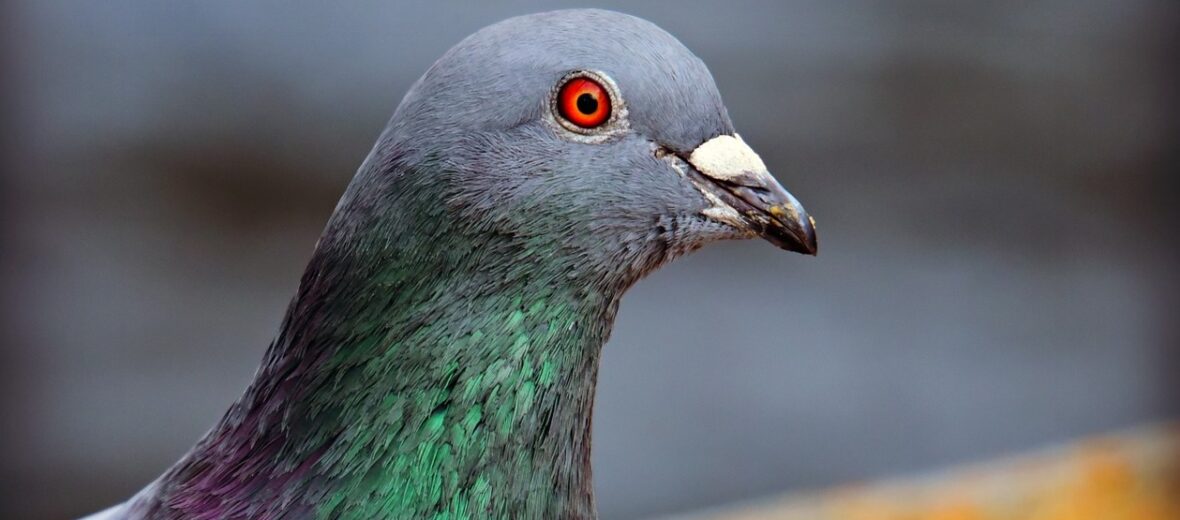
The pigeon is considered the world’s first domesticated bird. Records have shown that pigeons have been kept in captivity for over 5,000 years, dating back to Mesopotamia (modern Iraq) around 3000 BC. It is even believed that they have been domesticated since 8000 BC. They’ve also been a valuable food source for thousands of years. Despite their reputation as pests or even “rats with wings”, these birds are actually pretty cool; as long as they aren’t decorating your car with guano. The domestic pigeon is listed as Least Concern by the IUCN, due to their large population in every continent, sans the Sahara desert, Antarctica, and the Arctic. The greatest populations are in Malaysia, India, Asia, and Australia. Pigeons can be found in tropical rainforests, woodlands, grasslands, mangrove forests, savannas, rocky areas, deserts, urban, and suburban areas.
First the Stats…
Scientific name: Columba livia domestica
Weight: Up to 13 ounces
Length: Up to 14 inches
Wingspan: Up to 27 inches
Lifespan: Up to 15 years
Now on to the Facts!
1.) Charles Darwin’s love of pigeons influenced his 1868 book “The Variation of Animals and Plants Under Domestication”, which has 2 full chapters about the these birds. In comparison, cats and dogs got to share a single chapter.
2.) Nikola Tesla also loved pigeons. He was especially, and kind of creepily, fond of a white female pigeon whom he had stated that he had a love for which compared to how a man loves a woman. When the bird died, he was apparently inconsolable.
3.) Some species of pigeon can reach upwards of 19 inches long and over 8 lbs.!
4.) No one knows why, but some types of pigeons will actually roll backward and do somersaults in mid-flight! Some experts believe that this is done purely for entertainment.
5.) The feral pigeon which we typically see around town today is actually descended from the rock dove, a cliff-dwelling bird usually found in coastal regions. The word “pigeon” actually comes from the Latin word “pipio”. This means “young bird”. The word then found its way into Old French and was changed to “pijon” and from that, the English name “pigeon” was born.
But wait, there’s more on the pigeon!
6.) Scientists have concluded that these birds understand the concepts of both space & time. Researchers have noted that similar results have been found with humans and other primates. The only other bird to have this level of understanding is the crow.
7.) In both the 1st and 2nd World Wars the pigeon was credited for saving thousands of human lives by carrying important messages across enemy lines, through enemy fire and toxic gas.
Did you know…?
Pigeon guano (poop) was so highly prized as a fertilizer and considered to be far more potent than farmyard manure, in the 16th, 17th, and 18th centuries in Europe, that armed guards were stationed at the entrances to dovecotes (pigeon houses) to thwart thieves from stealing it!
8.) The earliest known full-scale communication network using these winged messengers was set up in Syria and Persia around the 5th century BC.
9.) These avian wonders have been documented finding their way back to their nests from as far away as 1,300 miles!
10.) There are 300 known species of pigeon! Some of these species are downright beautiful.
But wait, there’s still more on the pigeon!
11.) They are able to fly at altitudes of up to 6,000 feet!
12.) Another interesting fact is that they have learned to ride the subway and are actually model passengers. Perhaps a lesson to others.
13.) Like crows, these birds are able to recognize faces. In a study conducted by 2 women, one woman chased away pigeons, while the other fed them. The birds avoided the chaser as soon as they saw her, while they flocked to the girl who fed them and treated them with respect.
Did you know…?
they can understand abstract mathematical concepts, just like primates!
14.) Pigeons have extraordinary vision and are able to discern between nearly duplicate shades of color. Humans have a triple system of color perception but pigeons photo sensors and light filters allow them to tell the difference between as many as 5 spectral bands! This creates a world of a virtual kaleidoscope of colors. No wonder they seem a little spaced out at times.
15.) A study found that they could be taught to tell the difference between each letter of the alphabet. They actually recognize them in a way very similar to us humans.
But wait, there’s just a little more on the pigeon!
16.) The pigeon has side-mounted eyes. This gives them monocular vision rather than binocular vision. They actually bob their heads to aid in depth perception. The pigeon’s eyes work better with still images and thus as the pigeon takes 1 step forward, the head is temporarily left behind. The next step jerks the head forward again. Rinse, lather, repeat. This allows them to correctly orient themselves.
17.) Art critics? These domestic birds have even been trained to distinguish between different works of art.
Did you know…?
These critters are capable of flying at speeds of up to 100 mph, with a good tail wind!
18.) Pigeons, aka rock doves, are monogamous (mate for life).
19.) Females can breed up to 8 times a year in optimal conditions. They lay 2 eggs at a time.
Now a Short Pigeon Video!
Also, check out the Critter Science YouTube channel. Videos added frequently!
Want to suggest a critter for me to write about? Let me know here.



